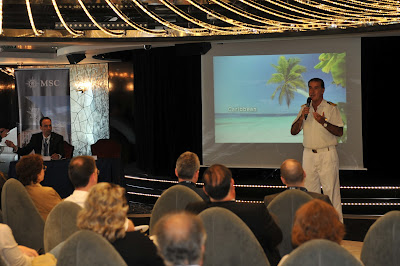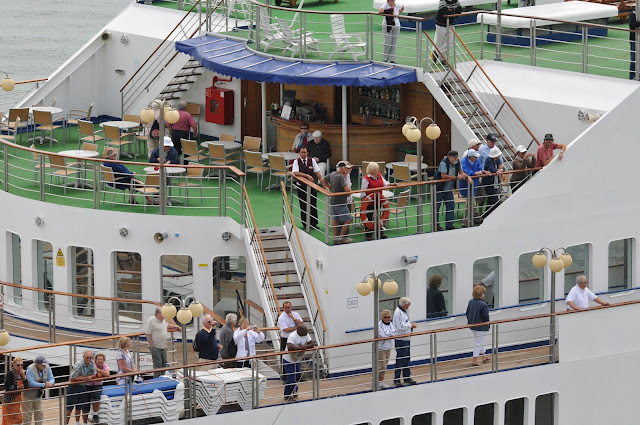
 O meu Querido Amigo Sr. George P. Potamianos faleceu esta manhã em Lisboa. Esta entrevista foi efectuada no seu escritório de Lisboa em Fevereiro de 2007, sendo agora republicada como homenagem a um grande armador e Amigo de Portugal. LMC - 29 de Maio de 2012
O meu Querido Amigo Sr. George P. Potamianos faleceu esta manhã em Lisboa. Esta entrevista foi efectuada no seu escritório de Lisboa em Fevereiro de 2007, sendo agora republicada como homenagem a um grande armador e Amigo de Portugal. LMC - 29 de Maio de 2012
Classic International Cruises Chairman Mr. George P. Potamianos gave me an interview to talk about his lifelong interest in passenger shipping and cruises, his Lisbon-based cruise company and his view of the cruise world.The original interview was published in the February issue of the magazine CRUISE & FERRY INFO.
As a special birthday feature, it is now posted in the SHIPS & THE SEA BLOG, as we commemorate our first anniversary today and are proud to record that yesterday we registered our 30,000 visitor.
“Classic International Cruises is a group of companies using a common trading name”, so tells me Mr. George Potamianos, the company’s chairman in his office overlooking the Alcântara dock and Lisbon main cruise terminals. He has been in Lisbon since the purchase of the cruise ship FUNCHAL in 1985.
The connections between Mr. Potamianos, the FUNCHAL and Portugal had started a decade earlier, with a charter from the Portuguese state-owned CTM company for a June to August 1976 series of summer cruises based in Gothenburg, operated by Fritidskyss in partnership with Mr. Potamianos. The venture was a successful one and so the FUNCHAL returned to Scandinavian waters every summer, being chartered by Stena in 1977 and by Potamianos / Fritidskryss from 1978 to 1985, becoming very popular with a regular following of Swedish repeat passengers.
The FUNCHAL had been constructed in Elsinore for Empresa Insulana as a dual purpose passenger mail and cruise ship delivered in October 1961. A 21-knot turbine steamship with accommodations for 400 PAX, she operated regularly from Lisbon to Madeira, Azores and the Canaries with some cruises to the Mediterranean and the Atlantic islands as well as special charter work as the President of Portugal’s yacht for state visits to the Azores, Madeira, West Africa and Brazil. In 1973 she was rebuilt as a cruise ship, the original turbines replaced by two Stork Werkspoor diesel engines and ownership was moved to CTM – Companhia Portuguesa de Transportes Marítimos in 1974 following the merger of Insulana with Cia. Colonial.
George Potamianos had developed good connections with Swedish cruising and travel interests: “I was looking for a suitable cruise ship to operate in 1976 in Scandinavia, when a broker from London suggested the FUNCHAL. I inspected the ship in Lisbon and was immediately caught by her”, says Potamianos. Several years operating the ship led to the establishment of Great Warwick Inc, who purchased the FUNCHAL in August 1985 at auction following a decision by the Portuguese government to close CTM and sell all ships. All the crew was retained and the FUNCHAL returned to Sweden in December 1985 for a long cruise to the Caribbean, thus starting the activities of Classic International Cruises.
An office was set up in Lisbon, Mr. Potamianos moved from Greece bringing the best in Greek cruise ship traditions. As a member of the Potamianos family, his roots in shipping go back to the 1880s when Georgios Potamianos, a native from Cephalonia, first started a shipping business. The Potamianos were associated to passenger shipping and cruises for most of the 20th century and the tradition is now carried on from Lisbon in a conservative efficient way. The FUNCHAL was followed by a second Portuguese ship, the 23,000 GRT INFANTE DOM HENRIQUE, rebuilt at a cost of 40 million USD as the VASCO DA GAMA and introduced in 1988. After a charter to Neckermann and seasons of cruising in the East Mediterranean and in Brazil, the VASCO DA GAMA was positioned in Aruba and her Caribbean cruises were so successful that in 1995 an attractive offer was made for her by Christian Stenby’s then emerging Cruise Holdings. VASCO changed hands becoming the SEAWIND CROWN, and George Potamianos looked for another ship. The BALTICA, formerly the DANAE was purchased in February 1996, refitted and introduced the following August as the PRINCESS DANAE. Fleet expansion continued with the acquisition in 1999 of the ASTRA 1. The 1965-built former ISTRA was totally gutted in Lisbon, rebuilt to modern standards and introduced in May 2000 as Classic International Cruises third ship. In 2004 another fine ship was obtained: the CARIBE of former Festival Cruises, which was refitted and renamed ATHENA, starting her cruising career with CIC in April 2005 as the new flagship.
In today’s cruising world of mega ships and large corporate groups, George Potamianos’ Classic International Cruises offers precisely the opposite: a family owned traditional operation with classic old ships kept in mint condition through a plan of continuous refitting and technical improvements, in-house ship management, friendly efficient crews and excellent food, imaginative itineraries.
From two niche markets in Sweden and Portugal in 1985, the company operations have increased in strength, and today the Classic International Cruises brand is present worldwide either under direct operation or on charter to other companies. CIC ships have cruised to most ports around the world, from the North Cape to Australia and the Far East. “Duration of cruises vary from 2-day to 115-day and our four ships have transported about 35,000 pax in 2006, generating a turnover of €60 million”, adds Mr. Potamianos. Against all odds, Classic International Cruises can be seen today as an independent alternative cruise group. Mr. Potamianos states his point of view: “It is my philosophy that passengers should travel on cruise ships to reach interesting destinations in comfort. We do not believe in pursuing passengers to collect their monies as onboard revenue, basically we prefer to generate our income from the sale of cruise tickets”; “We do not believe in repetitive cruise itineraries, more than 80 per cent of our cruises are different from each other and this helps us to base our operation on repeat passengers…” And this approach to the cruise market works as CIC has very high repeat passenger loads, depending from market to market, with a figure higher than 50 per cent in Portugal, about 40 per cent in Sweden, and about 25 per cent in the U. K. and Australia, where the FUNCHAL is now doing her third season. Classic International Cruises tailors its products to specific markets at a time: “As we prefer working with crews of one nationality, we also prefer to address one nationality of clients at a time in order to achieve better satisfaction in terms of services like food and entertainment, it is very important for us to have one single language onboard. However we also operate for multinational clientele”.
These days few companies thrive with old cruises ships. George Potamianos firmly believes in his classic older but very charming ships: “At Classic International Cruises we do not believe in mega-ships, neither in veranda floating resorts, which are anti-social, keeping passengers away from one another. And verandas drastically reduce promenade decks, leaving passengers no alternatives for a sunset moment other than their own cabins or the top decks…”
Mr. Potamianos is a keen enthusiast of his handsome elder ladies, always planning their next refitting and improvement. “On newly built ships one can not afford often changes and the refurbishment of arrangements and decorations that have recently cost fortunes, whether they proved successful or not. Also, entertaining repeaters, we find it interesting to present them often something new. On top of that, on a brand new ship you can hardly have the feeling of tradition that the history of an older one creates. As regards our preference, one more reason for that is that we can’t think exhausting our Captains expecting them to have, say, 3,000 handshakes weekly; in fact this must be the right job for twins”.
One of Mr. Potamianos best kept secrets is an efficient and dedicated staff of 1200 crew, a good number of them Portuguese, and 60 shore based persons. And with all four Classic International Cruises ships achieving a very high following with satisfied passengers, another ship is on the planning stage. “We are looking for an opportunity to find the right ship in order to expand”, says George Potamianos, adding that all his actual ships will sail past 2010: “the PRINCESS DANAE and the ATHENA are already fully complying with 2010 SOLAS, ARION is already 80 per cent ready, while the FUNCHAL is 20 per cent, we have just renewed a number of cabins in Estoril deck during her October refit, she is such an economical and reliable ship that it is worth spending money to upgrade her.”
Group profile – Classic International Cruises
CIC is a group of cruising companies using a common trading name, managed by Arcalia Shipping Co. Ltd., (established in Cyprus in 1985), with marketing and product supervision in charge of World Cruises Agency, Lisbon.
Chairman: George P. Potamianos
Vessels: ARION, ATHENA, FUNCHAL, PRINCESS DANAE
Company address:
Avenida 24 de Julho, 128, PT-1350-346 LISBOA, Portugal
Tel. +351 213 931 080
Fax. +351 213 978 244/5
Mr. G. Potamianos interviewed by L. M. Correia. Copyright original photos by Luís Miguel Correia - 16 February 2007


















































